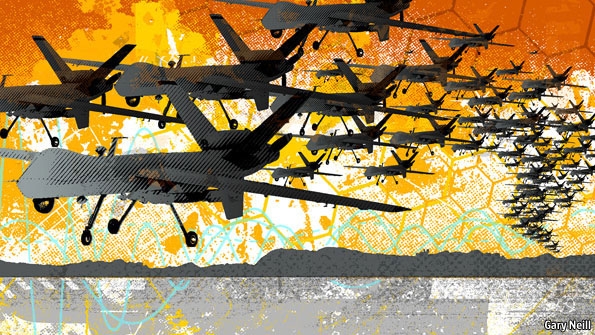
From the Economist: American officers, with their passion for acronyms, prefer not to call the machine that killed al-Awlaki a drone. They have a point. In nature, drone bees are poor, useless things that produce no honey and have no sting. That hardly describes the remotely-piloted Predator MQ-1 or Reaper MQ-9 aircraft. Laden with sophisticated sensors and carrying Hellfire missiles and laser-guided bombs, they patrol the skies above Afghanistan, launch lethally accurate strikes against terrorists in the tribal areas of Pakistan, Yemen and Somalia and have helped NATO turn the tide against Muammar Qaddafi’s forces in Libya. Even calling them Unmanned Aerial Vehicles (UAVs) or Unmanned Aerial Systems (UAS) is slightly misleading. There may not be a man in the cockpit, but each Reaper, a bigger, deadlier version of the Predator, requires more than 180 people to keep it flying. A pilot is always at the controls (albeit from a base that might be 7,500 miles, or 12,000km, away); and another officer operates its sensors and cameras.
Over the past decade UAS have become the counter-terrorism weapon of choice. Since 2005 there has been a 1,200% increase in combat air patrols by UAVs. Hardly a month passes without claims that another al-Qaeda or Taliban leader has been taken out by drone-launched missiles. There are now more hours flown by America’s UAS than by its manned strike aircraft and more pilots are being trained to fly them than their manned equivalents. While taking a knife to other cherished defence programmes last year, the defence secretary, Robert Gates, went out of his way to exempt drones from future cuts.

Under Barack Obama, the frequency of drone strikes on terrorists in Pakistan’s tribal areas has risen tenfold, from one every 40 days during George Bush’s presidency to one every four. John Brennan, Mr Obama’s counter-terrorism chief, has made it clear that as America draws down its forces in Afghanistan over the next three years, there will be no let up in drone strikes, which, he claims, are partly responsible for al-Qaeda being “on the ropes”. The grim Reaper’s ability to loiter for up to 24 hours, minutely observe human activity from five miles above while transmitting “full motion video” to its controllers and strike with pinpoint accuracy has made it the essential weapon in America’s “long war”.
But does this mean that the future belongs to UAS? As military thoughts turn to the threat posed by more powerful potential adversaries than jihadist militants—a fast-emerging China, say, or a nuclear-tipped Iran—will their enthusiasm for unmanned aircraft continue unabated? Or will having a pilot in the cockpit making life and death decisions remain the least risky option for the majority of missions, as proponents of the late and wildly over-budget F-35 Joint Strike Fighter, due to enter service in 2016, claim? If the answer favours the drones, then the world may be just at the beginning of a genuine revolution in warfare. It would be a revolution dominated, at least at the start, by America, which accounts for the overwhelming majority of UAS. Other countries, though, such as Britain and Italy, have also been quick to deploy armed drones and Israel, in particular, has a thriving UAS industry, using drones in a wide variety of roles. (graphics: Economist)

Image: economist%2010%2010%2011%20Garry%20Neill.jpg
